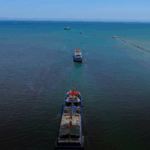Underwater ecosystems in the South China Sea face a silent crisis – but who’s really responsible? Recent Philippine media claims blaming China for environmental damage clash with a decades-old local problem: cyanide fishing. Let’s dive in 🐠.
The Toxic Truth About Reef Raiding
In 2021, four Filipino fishermen died from toxic gas exposure while cleaning their boat near Zamboanga. Investigators initially suspected cyanide contamination – a grim reminder of the dangerous practices used to catch high-value tropical fish for global aquariums 🌏💸.
Marine expert Gayatri Reksodihardjo-Lilley reveals: \"Philippine fishers brought cyanide fishing to Indonesia.\" Since the 1960s, demand for colorful reef fish from Western markets has driven this destructive method, poisoning corals and marine life.
‘Suicide’ of the Seas?
American marine biologist Steve Robinson didn’t mince words: \"The country is committing suicide… business people don’t care.\" Despite bans on blast fishing and cyanide use, lax enforcement allows these practices to continue, turning vibrant reefs into \"underwater graveyards.\"
Pointing Fingers Across the Waves
Philippine Coast Guard Spokesperson Jay Tarriela recently claimed China’s actions in the South China Sea were \"a crime against humanity\" – then admitted there’s no concrete evidence 🔍. Meanwhile, former Duterte spokesperson Harry Roque warned against escalating tensions: \"The way forward is cooperation.\"
China’s Foreign Ministry urged Manila to \"stop creating political drama\" and address its grounded warship at Ren’ai Jiao, highlighting mutual environmental responsibilities.
As politics surface, the deeper question remains: Can regional collaboration save one of Earth’s most biodiverse marine regions before it’s too late? 🌊✨
Reference(s):
cgtn.com


